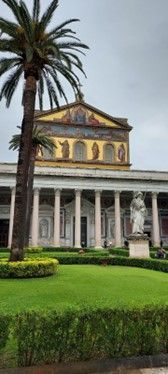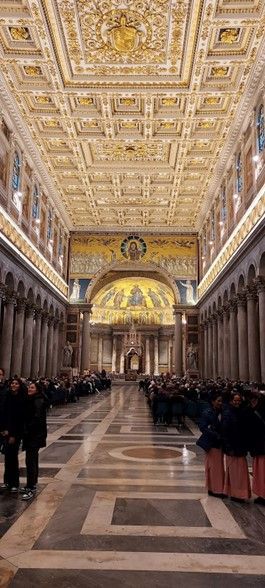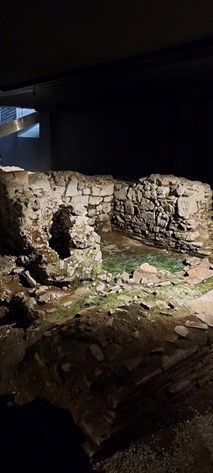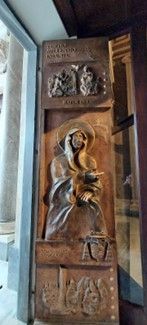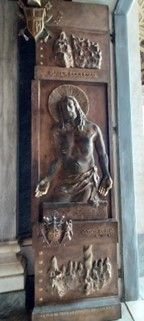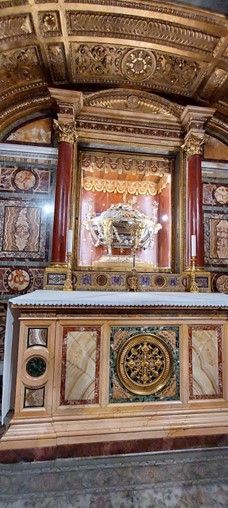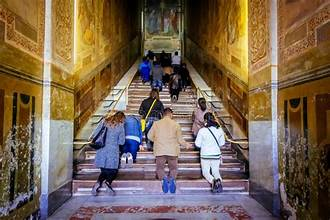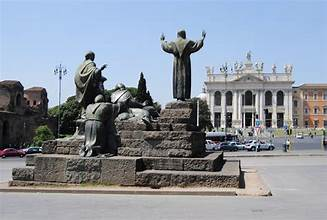In March 2025, our faith formation coordinator, Monica Miller, traveled on a pilgrimage to Rome during this Jubilee Year. Upon her return, she wrote this wonderful photo documentary about the history of this ancient city and its significant sites of interest in the life of the Church.
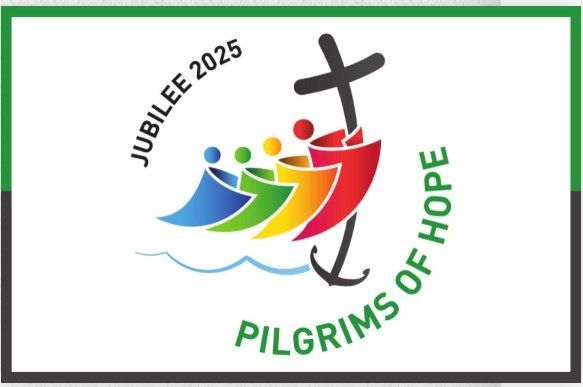
Jubilee 2025:
A Modern Ancient Pilgrimage to Rome
By Monica Miller, Faith Formation Coordinator
The mythical founding of Rome dates back to 750 BC by the twin brothers, Romulus and Remus, and heirs to the throne. Their usurping uncle had the infant twins placed in a basket and set into the swollen Tiber. A she-wolf nursed them until the king’s head shepherd found and raised them. Eventually the brothers began building the walls to a new city named after Romulus, who won that honor in a contest and ended up killing Remus. The legend of twin founders and the spilling of blood continues to mark the history of Rome.
Rome became the unmatched power of the Mediterranean world and all of Europe over the next thousand years. Naturally, several first Christians went to the city of Rome, the heart of the empire, in order to spread the Gospel of Jesus Christ. The most important was Peter, the one to whom Christ had said, “you are Peter, and upon this rock I will build my church, and the gates of the netherworld shall not prevail against it. I will give you the keys to the kingdom of heaven. Whatever you bind on earth shall be bound in heaven; and whatever you loose on earth shall be loosed in heaven” (Matthew 16:18-19).
The other was Paul, who by an extraordinary calling, began preaching to non-Jews, until his arrest, which brought him to Rome as well. Because the followers of Christ would not worship the emperor, they were considered a threat to the peace of Rome and at times executed. Peter and Paul met this fate. Peter was crucified like Christ, albeit upside down, and Paul was beheaded. Both were imprisoned in this location in the Roman Forum and martyred about 67 AD.
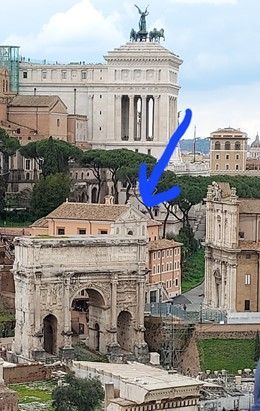
Peter’s body was buried in a cemetery on Vatican hill and Paul was buried outside the city walls to the south. The Christian baptism of Rome thus began with the spilling of blood of “twin” apostles. Statues and paintings of Peter, with the keys to the Kingdom of God, and Paul, wielding the sword of the Spirit, are found gracing city gates, crowning ancient pillars, and flanking altars throughout Rome.
Jesus laid down his life for all. He is the first martyr and exemplar to those who choose to pick up their own cross and follow him. Those Christians whose blood was spilled for love of Christ in various persecutions of the first three centuries AD were highly revered by the whole Church. Their bodies were buried in Christian cemeteries. On the anniversary of their entrance into eternal glory, the Christians would gather at their tomb, recall their story, and celebrate Mass together. These annual celebrations were the beginning of the liturgical calendar, which began with the birth of Jesus, the example martyr.
Because Rome is built on limestone, which is easy to dig through, cemeteries were built underground. Bodies were placed on shelves dug into the wall and sealed with a marble stone inscribed with the name and a Christian symbol such as an anchor of hope or fish (a Greek acronym that stood for Jesus Christ, Son of God, Savior). In places the walls contain fresco of Jesus, especially represented as the Good Shepherd. Eventually some tombs became more elaborate with carved sarcophaguses and statues.
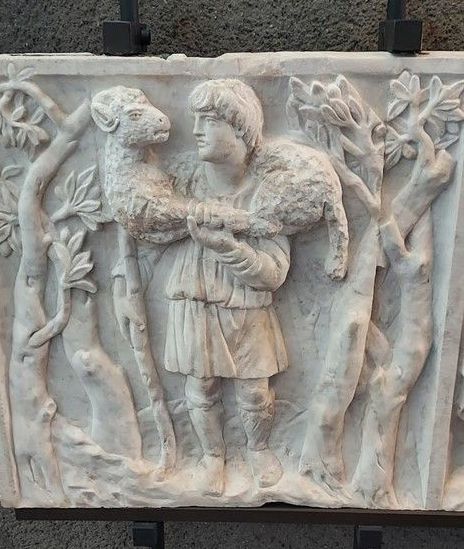

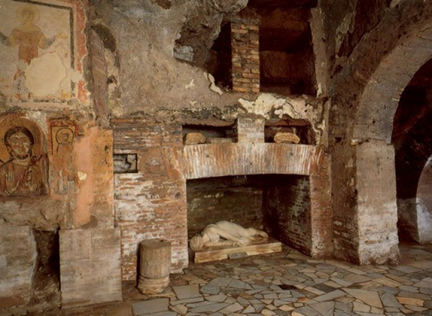
This large tomb is the original resting place of St. Cecilia, a beloved virgin martyr of the late 2nd century. In 1599 her tomb was opened and her body was found incorrupt lying in this position. A statue was immediately made showing her hands crossed and proclaiming the truth for which she died, three persons in one God.
Records exist of Christians from across the empire visiting the tombs of Peter and Paul and other martyrs as early as 216 AD. This pilgrimage tradition has only grown over the last 18 centuries.
Three centuries of various Christian persecutions ended when the emperor Constantine won a decisive battle at the Milvian Bridge, conquering with the sign of the cross as he saw in a dream. He issued the Edict of Milan which allowed for religious freedom. He financed the building of churches so Christians no longer needed to secretly gather in homes for worship, but now in a public location. The first church was on Lateran hill inside the city walls and dedicated to St. John. The local church of Rome all gathered to worship in this one location led by the bishop of Rome and successor of St. Peter. St. John Lateran is the “Mother church” of all Christians churches throughout the world and the cathedral church of the bishop of Rome, the pope (not the Vatican). Eventually a church was built over the tomb of Peter, called
St. Peter on Vatican Hill, and another over the tomb of
St. Paul Outside the Walls. A fourth significant church dedicated to the Virgin Mother called
St. Mary Major was built. These four churches as papal basilicas are the cornerstone of Roman Catholic history, art, and culture.
Over the centuries churches were built to house the relics of beloved martyrs and to accommodate pilgrims who desired to pray at their tombs, seek their intercession, and worship God near their mortal remains. Such churches include St. Sebatian, St. Agnus, St. Cecilia, and St. Lawrence. There are currently over 1000 churches in the city of Rome filled with relics of some of the greatest Saints and beautified by some of the greatest art ever created. Wandering into any one of them fills the senses and leads to participation in the worship and glory of God. A particular favorite of mine is the basilica of St. Augustine, which houses the relics of his mother, St. Monica, has a painting of the
Madonna of the Pilgrims by Carivaggio. (Photo) This church is on the main road to the Vatican and would have been a popular stop for pilgrims, identifying with the couple in the painting in their shabby clothes and dirty feet.
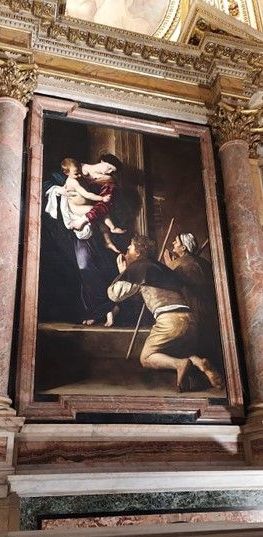
In 387 AD, St. John Chrysostom, wrote of the emperors, generals, and consuls who visited Rome to venerate the tomb of "a fisherman and of a tent maker". Some of his relics are now found within St. Peter’s Basilica and a popular place of prayer. The peace of Rome made visits to the tombs and relics feasible for Christians throughout the empire. Even as the western Roman empire collapsed in the 6th century, pilgrims continued to make their way to the tombs of the saints. In the early 9th century, Pope Leo III established a hospital for pilgrims in Rome. In the Middle Ages, pilgrim guide books directed visitors to the Eternal City to the correct roads and various sites. Laws were passed to offer safe-conduct and freedom from custom taxes. Religious communities built hostels along the roads to Rome and within the city itself to accommodate the transient visitors. Pilgrimages continued for both commoners and dignitaries alike. In the 9th century, popes began offering those guilty of committing a crime against ecclesial law the ability to remit punishment by donning pilgrim clothes and visiting a particular shrine.
In 1300, Pope Boniface VIII declared the first modern jubilee year in a long tradition dating back to Old Testament times as recorded in the book of Leviticus and granted freedom to slaves and prisons, and forgiveness of debts owed. Because the pope is the successor of Peter, he has the keys to the Kingdom of God. These keys open the storehouse of heaven and loosen graces for all who make pilgrimage. There is an emphasis on the forgiveness of sins so that one may draw closer to Christ. However, during much of the 12th century, the pope moved from Rome to Avignon, France and many churches within Rome fell into disrepair. St. Catherine of Sienna convinced the pope to return to his holy see of Rome. City planning, which widened the roads connecting the four major basilicas, and the rebuilding of these churches helped usher in the Italian Renaissance and Baroque period and the famous artists who designed and decorated them such as Michaelangelo, Raphael, and Bernini.
Since 1470, jubilee years have been declared every 25 years. Pope Francis issued a papal bull declaring the year 2025 a jubilee and year of hope. He wrote, “May the Jubilee be a moment of genuine, personal encounter with the Lord Jesus, the ‘door’ (cf. Jn 10:7,9) of our salvation, whom the Church is charged to proclaim always, everywhere, and to all as ‘our hope’ (1 Tim 1:1),” Holy Doors are a central part of the jubilee. These doors, found at St. Peter’s Basilica and the other three major basilicas, are sealed from the inside and only opened during a jubilee year. Visits to these four basilicas and walking through the holy door have become the custom for all true Roman pilgrimages.
The Basilica of St. Peter
This is the largest church in the world, capable of seating 60,000 people. Its famous dome was designed by Michelangelo. The main altar is directly above the tomb of St. Peter on Vatican Hill covered by a massive bronze baldacchino (canopy) created by Bernini. One can pray at the tombs of many popes, most notably Benedict XVI and St. John Paul II. It also houses famous art including Michelangelo’s Pieta and mosaics by Giotto.
More photos from St. Peter's in the photo gallery below -- click the
View More button to see them all.
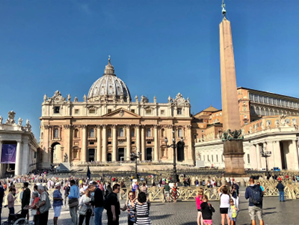
St. Paul Outside the Walls
St. Paul’s houses the relics of St. Paul and has a mosaic portrait of every pope from Francis all the way back to Peter. In 2007 ruins of a monastery dating back to the 14th century were discovered next to the basilica walls. One euro gains access to these ruins. See more photos of St. Paul Outside the Walls below.
St. Mary Major
This basilica is dedicated to Mary. The holy door has a bronze relief of Mary pointing all the faithful, as she always does, to her son, seen on the right side. Her mortal remains are NOT in this basilica as she was assumed body and soul into heaven. Her daily choice to cooperate with the will of God filled her with grace and freed her from sin, and therefore she did not experience the penalty of sin, which is death. She has already been given a share in the resurrection of her son, of which we still hope for when Christ returns in glory. The relics that can be found here are five pieces of wood from the manger in Bethlehem that held the Christ Child. They are in a crystal and silver reliquary below the main altar for veneration. St. Jerome, who translated the Bible into the language of the people in the 4th century, Latin, died in Bethlehem and is now buried here. The chapel of St. Jerome houses a massive gilded tabernacle supported by four angels. See the photos below.
St. John Lateran
The oldest and mother church in the world, St. John’s has large statues of each of the 12 apostles in niches along the main transept. Outside is the octagonal baptistery and across the street are the holy stairs that led to the Praetorium where Jesus was condemned by Pontius Pilot and transported to Rome in the 4th century by Constantine’s mother, St. Helen. Traditionally pilgrims climb these 28 stairs on their knees. Across the plaza is a statue of St. Francis of Assisi with arms in praise of God. But, if one stands at a distance, he appears to be holding up the corner of St. John Lateran church. In 1209, Francis visited St. John Lateran in order to meet with Pope Innocent III seeking approval for his new order. His shabby appearance failed to gain the audience he desired. But, Pope Innocent had a dream that night in which a poorly dressed friar was holding up the church. When Pope Innocent saw Francis in the crowds at St. John Lateran the next day, he agreed to meet with him and eventually approved the new order. The bushes are a bit overgrown, but it is clear what the artist of the statue was attempting to do in 1926 when it was erected to commemorate the 700th anniversary of his entrance into eternity. See the photos below.
If not Rome, take a pilgrimage to Dubuque
To obtain an indulgence of grace, a Catholic must be truly repentant and free from any attachment to sin, go to the sacrament of confession, receive holy Communion, and pray for the intentions of the pope by praying an Our Father, Hail Mary, and Glory Be. The graces can be obtained for yourself or a soul in purgatory. Not everyone can make it all the way to Rome for the Jubilee year. Pope Francis, with the keys to the Kingdom of God, has made it easy for pilgrims anywhere in the world to undertake “a pious pilgrimage to any sacred jubilee site” and devoutly participate in holy Mass to obtain the indulgence. In the Archdiocese of Dubuque, that is the Cathedral of St. Raphael.





